Increasing Cyber Threat Landscape
The cloud sandboxing market in China is experiencing growth due to the escalating cyber threat landscape. As organizations face a surge in sophisticated cyberattacks, the need for advanced security solutions becomes paramount. In 2025, it is estimated that cybercrime could cost the global economy over $10 trillion annually, prompting Chinese enterprises to invest in cloud sandboxing technologies. These solutions allow for the safe execution of potentially harmful code in isolated environments, thereby mitigating risks. The increasing frequency of ransomware attacks and data breaches has led to a heightened awareness of cybersecurity, driving demand for cloud sandboxing solutions. Consequently, businesses are prioritizing investments in these technologies to protect sensitive data and maintain operational integrity, indicating a robust growth trajectory for the cloud sandboxing market in China.
Government Initiatives and Support
The Chinese government is actively promoting cybersecurity initiatives, which significantly impacts the cloud sandboxing market. With the implementation of policies aimed at enhancing national security, there is a growing emphasis on protecting critical infrastructure and sensitive data. The government has allocated substantial funding to support cybersecurity research and development, which includes cloud sandboxing technologies. In 2025, the Chinese government is expected to invest approximately $2 billion in cybersecurity initiatives, fostering innovation and adoption of advanced security solutions. This support not only encourages local enterprises to adopt cloud sandboxing but also attracts foreign investments in the sector. As a result, the cloud sandboxing market is likely to benefit from these initiatives, leading to increased market penetration and technological advancements.
Integration of Artificial Intelligence
The integration of artificial intelligence (AI) into cybersecurity solutions is emerging as a significant driver for the cloud sandboxing market. AI technologies enhance the capabilities of cloud sandboxing by enabling real-time threat detection and automated response mechanisms. In China, the AI market is projected to reach $30 billion by 2025, with a substantial portion allocated to cybersecurity applications. This integration allows organizations to analyze vast amounts of data quickly, identifying potential threats before they can cause harm. As businesses increasingly recognize the value of AI in enhancing their security frameworks, the demand for cloud sandboxing solutions that incorporate AI capabilities is likely to rise. This trend suggests a promising future for the cloud sandboxing market, as organizations seek to leverage advanced technologies to bolster their defenses against cyber threats.
Growing Cloud Adoption Across Industries
The rapid adoption of cloud computing across various industries in China is significantly influencing the cloud sandboxing market. As organizations migrate to cloud environments, the need for robust security measures becomes increasingly critical. In 2025, it is estimated that the cloud services market in China will surpass $100 billion, driving the demand for complementary security solutions such as cloud sandboxing. This technology enables businesses to test applications in a secure environment, ensuring that any vulnerabilities are identified and addressed before deployment. The growing reliance on cloud infrastructure across sectors such as finance, healthcare, and e-commerce is likely to propel the adoption of cloud sandboxing solutions, indicating a strong growth potential for the market.
Rising Demand for Data Privacy Solutions
In the context of the cloud sandboxing market, the increasing demand for data privacy solutions is a critical driver. As data breaches and privacy violations become more prevalent, organizations in China are compelled to adopt measures that ensure compliance with data protection regulations. The cloud sandboxing market provides a viable solution by allowing businesses to test and analyze potentially harmful applications without risking sensitive information. In 2025, it is projected that the data privacy market in China will reach $5 billion, reflecting a growing awareness of the importance of safeguarding personal data. This trend is likely to propel the adoption of cloud sandboxing technologies, as companies seek to enhance their security posture and protect customer information, thereby driving growth in the cloud sandboxing market.

















Leave a Comment